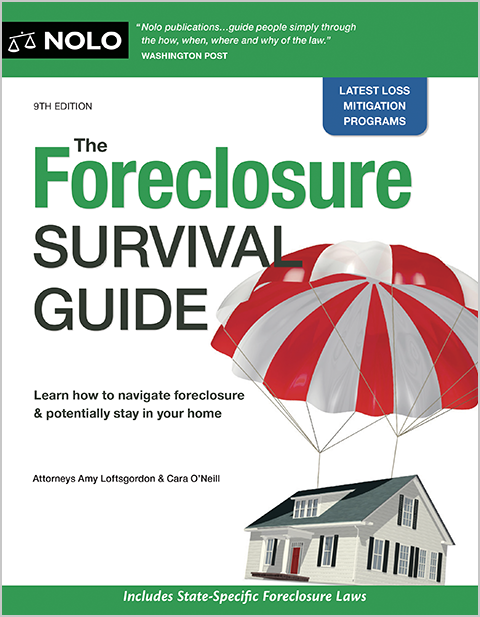If you're facing foreclosure, you might be able to stop the process by filing for bankruptcy, applying for a loan modification, or filing a lawsuit.
If you're behind on your mortgage payments and a foreclosure sale is looming, you might still be able to save your home. You can potentially file for bankruptcy or file a lawsuit against the foreclosing party (the "bank") to possibly stop the foreclosure entirely or at least delay it.
If you have some more time on your hands, you can apply for a loan modification or another workout option.
File for Bankruptcy to Stop the Foreclosure
If a foreclosure sale is scheduled to occur in the next day or so, the best way to stop the sale immediately is by filing for bankruptcy. Once you file for bankruptcy, something called an "automatic stay" immediately goes into effect. The stay functions as an injunction prohibiting the bank from foreclosing on your home or otherwise trying to collect its debt. So, any foreclosure activity must be halted, at least temporarily.
Chapter 13 Bankruptcy vs. Chapter 7 Bankruptcy
If you want to keep your home, a Chapter 13 bankruptcy might help you accomplish this goal. This kind of bankruptcy allows you to make up the missed payments as part of a three- to five-year plan. A Chapter 7 bankruptcy doesn't provide this kind of help. But if you're trying to buy some time by stalling the foreclosure and eliminate other debts, a Chapter 7 bankruptcy might be right for your situation.
(Note that if saving your home is your main goal and you have time, you should first explore the many nonbankruptcy options for avoiding foreclosure, like a loan modification. You might be able to keep your home and get current on a mortgage arrearage without filing for bankruptcy. However, you'll need time to apply for and, hopefully, get a modification. If a foreclosure sale is approaching quickly, filing for bankruptcy might be your only option.)
Benefits of a Chapter 13 Bankruptcy to Avoid Foreclosure
A Chapter 13 bankruptcy can help you keep your home if you're behind in mortgage payments. While a Chapter 7 can delay a foreclosure temporarily, it won't block it permanently because you can't make up the missed payments. People behind on a mortgage who want to keep a house should consider filing for Chapter 13 instead. You will repay debts, some in part and some in full, over three to five years as part of a repayment plan. You might be able to avoid foreclosure and remain in your home with this type of bankruptcy because you can repay any delinquent mortgage payments through the plan.
Also, you will likely pay a fraction (or sometimes, none) of your unsecured debts during the plan period and possibly eliminate certain other debts—like underwater second and third mortgages because they're considered unsecured loans—entirely when you complete your plan, freeing up money for your first mortgage. Even if you can't complete the plan, filing for Chapter 13 bankruptcy will give you at least several months before a foreclosure can be completed.
Benefits of a Chapter 7 Bankruptcy in a Foreclosure
If you're behind in your mortgage payments, Chapter 7 bankruptcy provides temporary relief through the automatic stay, which halts foreclosure proceedings for a few months. It can also free up money by eliminating other debts.
But if you're already behind in payments or in foreclosure, filing Chapter 7 bankruptcy isn't a good way to save your home. To keep your house in a Chapter 7 bankruptcy, you must be able to meet two requirements: Your payments must be current, and you must be able to protect all your home equity when filing.
Also, the bank will probably attempt to have the stay lifted by filing a motion seeking permission from the court to continue with the foreclosure. The bankruptcy court will probably grant this motion and allow the foreclosure to proceed. Still, the foreclosure will be delayed for a while.
As a general rule, filing for Chapter 7 bankruptcy is a bad idea if you have little or no debt that would be discharged, and your only reason for filing is to buy some extra time in your house. You can't get another Chapter 7 discharge for eight years. It doesn't seem worth filing just to get a little extra time, maybe a couple of months, in your home. Also, the courts frown on filers using bankruptcy for tactical purposes.
But if you're facing foreclosure, you also probably have some serious debt issues. If Chapter 7 would eliminate much of that debt as well as buy you some more time in your home, the equation changes; Chapter 7 bankruptcy becomes a valid option you could file in "good faith." And, even if you still go through a foreclosure, a Chapter 7 bankruptcy can eliminate your personal liability for the mortgage debt, which means you won't be liable for any deficiency remaining after the foreclosure. Find out if you potentially qualify for a Chapter 7 bankruptcy.
Be aware that if you already filed for bankruptcy within the past year, the stay could be limited to 30 days or eliminated.
File a Lawsuit to Stop a Foreclosure
If your bank is using a nonjudicial process to foreclose, where the foreclosure is completed outside of the court system, then you might be able to delay or stop the foreclosure sale by filing a lawsuit against the bank.
Stopping a Nonjudicial Foreclosure
You must include a motion for a temporary restraining order and preliminary injunction to enjoin (stop) a foreclosure sale while your claims are being litigated. (This tactic normally won't work if the foreclosure is judicial because, by the time of a foreclosure sale, you've already had your opportunity to be heard in court.)
What You Need to Prove
To prevail, you'll need to prove to the satisfaction of the court that the foreclosure should not take place because, for example, the foreclosing bank:
- can't prove it owns the promissory note
- didn't act in compliance with state mediation requirements (you might also be able to delay a foreclosure or work out a way to avoid it by participating in foreclosure mediation)
- violated a state law, like a Homeowner Bill of Rights law
- didn't follow all of the required steps in the foreclosure process (as determined by state law), or
- made some other grievous error.
The downside to suing your bank is that you'll only briefly delay the foreclosure process if you can't prove your case. Lawsuits can be expensive, and if you have no reasonable basis for your claims, you could get stuck paying the bank's court costs and attorneys' fees.
Apply for a Loan Modification
While you can't wait until the very last minute with this option, you might be able to delay a foreclosure by applying for a loan modification or another foreclosure avoidance option because the bank could be restricted from dual tracking. "Dual tracking" is when the bank proceeds with the foreclosure while a loss mitigation application is pending.
If your modification application is approved, the foreclosure will be permanently stopped if you keep up with the modified payments.
Some State Laws Prohibit Dual Tracking
California, Colorado, Nevada, and Minnesota, for example, have each passed a Homeowner Bill of Rights that prohibits the dual tracking of foreclosures. Servicers generally must make a decision to grant or deny a (typically) first-lien loss mitigation application before starting or continuing the foreclosure process.
You must submit your application by a certain deadline to get protection from foreclosure under these laws. (For example, in California, you must submit a complete application for a first lien loan modification at least five business days before a scheduled foreclosure sale. Then, the bank can't conduct a foreclosure sale while the application is pending. Keep in mind that the bank might deny your request for a modification.) Talk to a lawyer to find out specific deadlines.
Federal Rules Restrict Dual Tracking
Under federal law, if a complete loss mitigation application is received more than 37 days before a foreclosure sale, the servicer may not move for a foreclosure judgment or order of sale, or conduct a foreclosure sale, until:
- the servicer informs the borrower that the borrower is not eligible for any loss mitigation option (and any appeal has been exhausted)
- the borrower rejects all loss mitigation offers, or
- the borrower fails to comply with the terms of a loss mitigation option, such as a trial modification.
Be aware that the servicer generally doesn't have to review more than one loss mitigation application from you. But if you bring the loan current after submitting an application, the servicer must consider it.
Talk to an Attorney About Preventing a Foreclosure
If you're facing an imminent foreclosure sale and considering any of the options discussed in this article, it is strongly recommended that you consult with a local foreclosure attorney or bankruptcy attorney immediately.
To get information about different loss mitigation options, you should also consider talking to a HUD-approved housing counselor.

